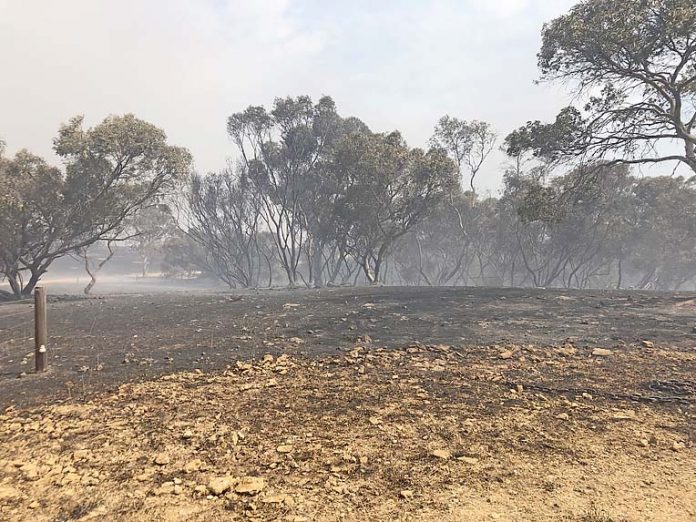

THOUSANDS of sheep and cattle are believed to have been killed and several farm houses destroyed by a bushfire west of Padthaway which Country Fire Service volunteers and landowners continued to patrol late yesterday.
Almost 25,000 hectares of land has been reduced to ash by the Keilira fire, which was ignited Monday morning by dry lightning strikes.
The CFS downgraded the fire’s status yesterday as crews patrolled the scene, with the devastating impacts clear to see in daylight hours after a lengthy battle which continued into the early hours of Tuesday.
MacKillop MP and Conmurra grazier Nick McBride, who was at the scene yesterday to help in the clean up, said he was aware three homes had been destroyed.
“One was a family home and another two unoccupied homes were also burned down,” he said.
Mr McBride said the blaze had killed thousands of animals and described the scenes as “shocking”.
“This is such as big fire and it is still burning,” he said.
“I have seen dead cows, calves and sheep as well as animals which were burning alive.
“It is shocking.”
CFS personnel fought intensely against the blaze in the early hours of yesterday morning, with dense scrub hindering firefighting tactics.
A wind change on Monday afternoon caused the fire to spread uncontrollably and it had burned 24,750 hectares by mid-yesterday.
The fire was raised to a Level 2 incident on Monday and residents in the area were advised to watch and act as the blaze threatened a number of properties.
Wattle Range CFS group officer Fred Stent joined a strike team of five crews to help fight the blaze on Monday night.
Speaking to The Border Watch after arriving home from the shift yesterday morning, Mr Stent said it was a busy night on the fireground.
“We started at around 7.30pm and finished at 6.30am,” Mr Stent said.
“We were involved in back-burning and patrolling the fire, which was going very well all night,” Mr Stent said.
Mr Stent said there were three fronts of the fire and crews were first required to tackle the south-eastern front.
“It took us around four hours to get that under control, I think we did a reasonably good job,” Mr Stent said.
“It was burning in pretty thick scrub, we could not get in there, so were just made breaks and waited for the fire to come out.”
Mr Stent said the wind made firefighting difficult all evening.
“It was pretty intense as the winds were up fairly well, so we just had to slow the fire as much as we could,” he said.
“We protected three or four properties throughout the evening.”
The fire threat was reduced to a bushfire advice message yesterday.
Rapid damage assessment teams visited the fire ground yesterday to assess items damaged during daylight hours.
A CFS spokesperson said they had every confidence in the crews who would monitor the fire over the coming days.
Heavy machinery has been used to create breaks outside of the fireground.
The CFS has urged motorists to exercise caution as there was significant smoke in the areas which may limit visibility across the Riddoch Highway and surrounding areas for the next few days.
The area will also be under close scrutiny ahead of Friday’s forecast temperatures into the low to mid 40s.









